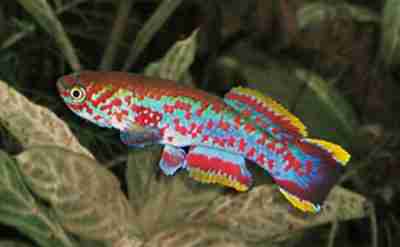 Today we travel to the verdant forests of Eastern Nigeria, following the meandering path of the Cross River and its associated systems. Dense rainforests envelop this area, the humidity creating mists and fogs. Here is one of the last bastions of Cross River Gorillas, only fully described in 2000, first filmed in 2007. We have entered into a hostile land plagued by Ebola and Malaria. Seasonal flooding makes the region rife with mudslides and flash floods.
Today we travel to the verdant forests of Eastern Nigeria, following the meandering path of the Cross River and its associated systems. Dense rainforests envelop this area, the humidity creating mists and fogs. Here is one of the last bastions of Cross River Gorillas, only fully described in 2000, first filmed in 2007. We have entered into a hostile land plagued by Ebola and Malaria. Seasonal flooding makes the region rife with mudslides and flash floods.
Away from the major river in its tributaries and creeks we spot a vibrant blue, red, and yellow fish dancing among the leaves and bracken. We have found our quarry, the Steel Blue or Blue Lyretail Killifish (Fundulopanchax gardneri).
Most killis are either annuals (seasonal, so short-lived) or non-annuals (live for a few years in larger bodies of water). These are switch or semi-annuals, having both traits. They may live a few years and do not need their eggs dried to hatch, but can be dried.
These also exhibit quite varied coloration depending on their collection point, so care should be exercised to avoid hybridization and loss of their unique characteristics. Current collection points are Akaram, Akure, Enugu, Kluge, Lafia, Makurdi, Nsukka, Okwoga, and Udi Mountain. Most fish are labeled with a location, and year, possibly even a number detailing the exact person and dates they were collected.
The males are amazing to behold, the females are the more subdued, so sexing is relatively easy. They are voracious eaters, but prefer live or frozen fare. They do best in smaller, shallow tanks. Care must be taken, these are jumpers. Cover those tanks. I have even seen them do fine in Tupperware or critter keepers. Filtration helps, or even an airstone and regular water changes.
They do well in softer water, from 6.0 to 7.5 ph and 18-180 TDS. Mixing RO or rainwater and tap should get you into the ballpark. They love floating plants but a blackwater tank can suit them fine as well. They prefer cooler water from 68-78F, so unheated in a generally normal household should be ok.
Males can reach 2-2.5″, females just a bit smaller. Growth is fast, as many can be seasonal. Spawning is done on peat, mosses, or a spawning mop. Eggs should be removed as they will eat them. Males are highly territorial, so avoid multiple males in smaller tanks. A harem of 2-3 females and 1 male produces copious amounts eggs every few weeks. The eggs hatch in 14-21 days submerged and if dried 3-4 weeks are required for reimmersion in water. Fry are larger, so feeding baby brine or similarly sized fare should be perfect.
These are a delightful first step into killifish and are a classic in that aspect. They have been a staple in the hobby, going back to its earliest days. If I were to recommend a good starter this would be on that list. Many point out freshwater aquarium fish lack the color of their marine cousins. Killis break that rule. They are little jewels in our home, consider one. You will not be disappointed.
by Roy Williams
 Biotope One A Study of Flora and Fauna
Biotope One A Study of Flora and Fauna 


